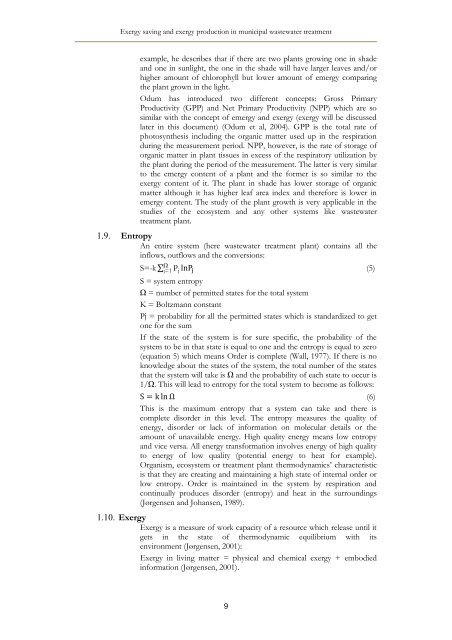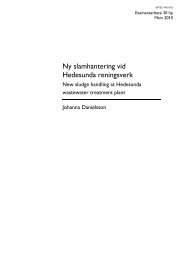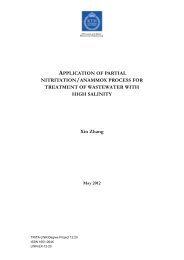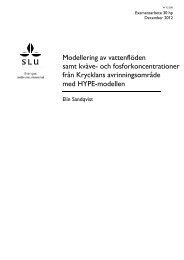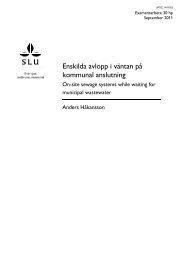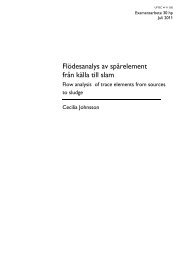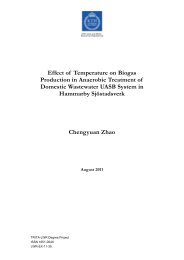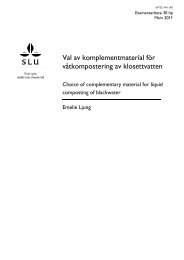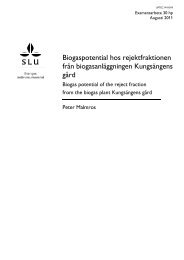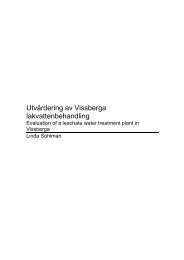Exergy saving and exergy production in municipal wastewater ...
Exergy saving and exergy production in municipal wastewater ...
Exergy saving and exergy production in municipal wastewater ...
You also want an ePaper? Increase the reach of your titles
YUMPU automatically turns print PDFs into web optimized ePapers that Google loves.
<strong>Exergy</strong> <strong>sav<strong>in</strong>g</strong> <strong>and</strong> <strong>exergy</strong> <strong>production</strong> <strong>in</strong> <strong>municipal</strong> <strong>wastewater</strong> treatment<br />
example, he describes that if there are two plants grow<strong>in</strong>g one <strong>in</strong> shade<br />
<strong>and</strong> one <strong>in</strong> sunlight, the one <strong>in</strong> the shade will have larger leaves <strong>and</strong>/or<br />
higher amount of chlorophyll but lower amount of emergy compar<strong>in</strong>g<br />
the plant grown <strong>in</strong> the light.<br />
Odum has <strong>in</strong>troduced two different concepts: Gross Primary<br />
Productivity (GPP) <strong>and</strong> Net Primary Productivity (NPP) which are so<br />
similar with the concept of emergy <strong>and</strong> <strong>exergy</strong> (<strong>exergy</strong> will be discussed<br />
later <strong>in</strong> this document) (Odum et al, 2004). GPP is the total rate of<br />
photosynthesis <strong>in</strong>clud<strong>in</strong>g the organic matter used up <strong>in</strong> the respiration<br />
dur<strong>in</strong>g the measurement period. NPP, however, is the rate of storage of<br />
organic matter <strong>in</strong> plant tissues <strong>in</strong> excess of the respiratory utilization by<br />
the plant dur<strong>in</strong>g the period of the measurement. The latter is very similar<br />
to the emergy content of a plant <strong>and</strong> the former is so similar to the<br />
<strong>exergy</strong> content of it. The plant <strong>in</strong> shade has lower storage of organic<br />
matter although it has higher leaf area <strong>in</strong>dex <strong>and</strong> therefore is lower <strong>in</strong><br />
emergy content. The study of the plant growth is very applicable <strong>in</strong> the<br />
studies of the ecosystem <strong>and</strong> any other systems like <strong>wastewater</strong><br />
treatment plant.<br />
1.9. Entropy<br />
An entire system (here <strong>wastewater</strong> treatment plant) conta<strong>in</strong>s all the<br />
<strong>in</strong>flows, outflows <strong>and</strong> the conversions:<br />
=-k =1 P<br />
(5)<br />
S = system entropy<br />
= number of permitted states for the total system<br />
K = Boltzmann constant<br />
Pj = probability for all the permitted states which is st<strong>and</strong>ardized to get<br />
one for the sum<br />
If the state of the system is for sure specific, the probability of the<br />
system to be <strong>in</strong> that state is equal to one <strong>and</strong> the entropy is equal to zero<br />
(equation 5) which means Order is complete (Wall, 1977). If there is no<br />
knowledge about the states of the system, the total number of the states<br />
that the system will take is <strong>and</strong> the probability of each state to occur is<br />
1/ . This will lead to entropy for the total system to become as follows:<br />
(6)<br />
This is the maximum entropy that a system can take <strong>and</strong> there is<br />
complete disorder <strong>in</strong> this level. The entropy measures the quality of<br />
energy, disorder or lack of <strong>in</strong>formation on molecular details or the<br />
amount of unavailable energy. High quality energy means low entropy<br />
<strong>and</strong> vice versa. All energy transformation <strong>in</strong>volves energy of high quality<br />
to energy of low quality (potential energy to heat for example).<br />
Organism, ecosystem or treatment plant thermodynamics’ characteristic<br />
is that they are creat<strong>in</strong>g <strong>and</strong> ma<strong>in</strong>ta<strong>in</strong><strong>in</strong>g a high state of <strong>in</strong>ternal order or<br />
low entropy. Order is ma<strong>in</strong>ta<strong>in</strong>ed <strong>in</strong> the system by respiration <strong>and</strong><br />
cont<strong>in</strong>ually produces disorder (entropy) <strong>and</strong> heat <strong>in</strong> the surround<strong>in</strong>gs<br />
(Jørgensen <strong>and</strong> Johansen, 1989).<br />
1.10. <strong>Exergy</strong><br />
<strong>Exergy</strong> is a measure of work capacity of a resource which release until it<br />
gets <strong>in</strong> the state of thermodynamic equilibrium with its<br />
environment (Jørgensen, 2001):<br />
<strong>Exergy</strong> <strong>in</strong> liv<strong>in</strong>g matter = physical <strong>and</strong> chemical <strong>exergy</strong> + embodied<br />
<strong>in</strong>formation (Jørgensen, 2001).<br />
9


